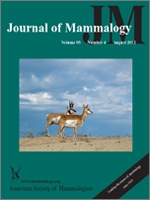Forest fragmentation demonstrably alters plant species composition, distribution, and diversity, and, in turn, may affect the availability of food resources for primary consumers. We investigated to what extent fragmentation affected the diets of 6 groups of bearded saki monkeys (Chiropotes chiropotes) living in two 10-ha fragments, two 100-ha “fragments” that were no longer fully isolated, and 2 areas of continuous forest in central Amazonia. When changes occurred we tested whether differences in diet were due to plant species availability by comparing the prevalence of consumed items against their relative abundance at the 6 sites. In total, the monkeys consumed fruits, seeds, flowers, and leaves of 244 plant species, of which less than 2% were shared among all 6 groups. Although there was a positive correlation between relative abundance of diet species and consumption frequency, monkeys did not eat all available potential resources, and groups inhabiting the 10-ha fragments consumed items that were ignored in larger forested areas. Our findings suggest that bearded sakis living in small forest fragments are limited in their dietary choices as a consequence of the reduced number of plant species present, and therefore consume species that monkeys inhabiting continuous forests typically can ignore. We conclude that the ability to consume a diverse diet that includes seeds and unripe fruit helps this species survive in forest fragments, but it appears that these conditions are unviable unless connectivity increases among the forest fragments and continuous forest in the landscape.
Comprovadamente a fragmentação florestal altera a composição das espécies de plantas, sua distribuição e diversidade, afetando por sua vez a disponibilidade de recursos para consumidores primários. Neste contexto, investigamos se a fragmentação florestal afetou as dietas de 6 grupos de macaco-cuxiú (Chiropotes chiropotes) presentes em 2 fragmentos florestais de 10 ha isolados, 2 de 100 ha parcialmente isolados, e em 2 áreas de mata contínua na Amazônia Central. Quando mudanças foram detectadas, nós testamos se as diferenças nas dietas foram relacionadas à disponibilidade de recursos, comparando a prevalência de itens consumidos em relação à sua abundância relativa nos 6 sítios amostrados. No total, os macacos consumiram frutos, sementes e flores de 244 espécies vegetais, das quais menos de 2% foram consumidas por todos os 6 grupos. Embora houve uma correlação positiva entre abundância relativa de espécies utilizadas na dieta e frequência de consumo, os macacos não utilizaram todas as espécies de plantas disponíveis no ambiente, e grupos habitantes de fragmentos de 10 ha consumiram recursos que foram ignorados pelos demais em ambientes florestais de maior porte. Nossos resultados sugerem que cuxiús que habitam pequenos fragmentos florestais são limitados em suas escolhas alimentares em consequência do número reduzido de espécies vegetais presentes e, como consequência, consomem espécies de plantas que são ignoradas pelos que habitam floresta contínua. Nós concluímos que a capacidade de utilizar uma dieta diversa, como sementes e frutos imaturos, contribui para que este primata sobreviva em fragmentos florestais. No entanto, esta condição nos parece viável somente se houver maior conectividade entre os fragmentos e florestas contínuas dentro da paisagem.





